

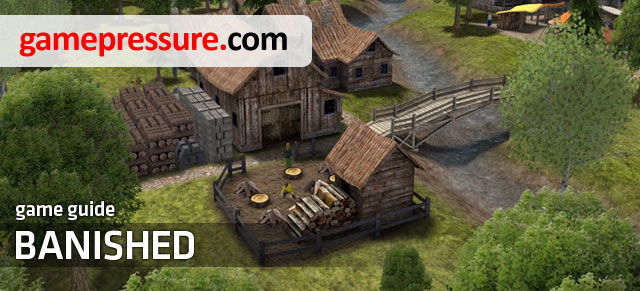
The strategy guide for Banished is a complete guide for the medieval game by Shining Rock Studios. You'll find advice on real and harmonious functioning of a village you create here. In the guide, there is information about starting the game properly and producing food - a resource that determines the development of population. There are also pieces of advice on producing and preparing natural resources. The walkthrough contains a list of all buildings along with their description and cost. A separate chapter is related to the basic aspects of gameplay - you'll find there some advice on interface, managing workers, trade and nomads. There's also information that lets you go through specific ways of beginning the game, when essential things happen - you'll find a description of all seasons along with actions you need to take to minimize the effects of natural disasters and events like cold, drought or famine. There's also a list of all achievements offered by Steam and a description of getting them. Banished is an economic real-time strategy game. It's been created by Shining Rock Software studio as their debut project. In Banished the player commands a group of people who have been banished from their city and have to find a place to build a village. It's not an easy task, the first winter might be fatal for the villagers if you don't prepare them for the cold properly.
Banished strategy guide contains:
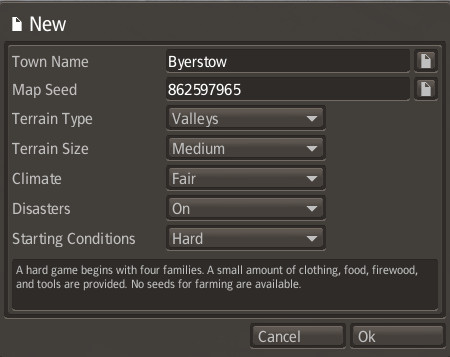
There is no specific single player campaign in Banished - you can adjust some conditions instead, using a simple panel that pops up before starting the game.
Town Name - here you can specify the name of your village or select a random one;
Map Seed - here you'll choose a random map from over a dozen available;
Terrain Type - here you'll select one of two terrain types:
Terrain Size - here you'll specify the size of the map you'll be working with using three available options (small, medium, large);
Climate - in this panel you'll choose the climate during the game. You can choose between mild, fair, and harsh;
Disasters - here you can turn the natural disasters on and off;
Starting Conditions - here you'll select one of three available types of starting conditions:
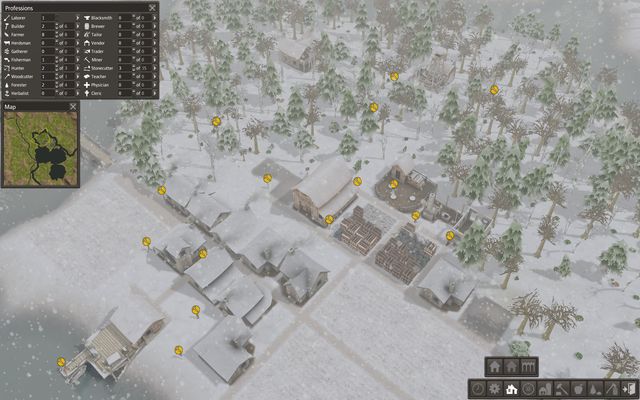
Using the interface in Banished doesn't cause too much trouble.
The interface in Banished is very intuitive and suitable even for beginners. All essential options can be found in the lower right corner. By clicking the icons, you'll access:
- Simulation Speed - you can adjust speed of time from 1x to 10x or stop the time;
- Tools & Reports - it's one of the bridge important panels in the game - here you can assign villagers to professions, set production limits of resources, or see general gameplay stats. Moreover, you can set priorities for specific activities during the game;
- House & Housing - here you can build three types of housing;
- Roads & Bridges - as the title might suggest, here you can build roads and bridges;
- Storage, Market & Trade - here you can build a new storage barn, extend the area where you store resources or open a market;
- Town Services - here you can build some buildings that provide services to the citizens, e.g. chapel, cemetery, hospital or town hall;
- Food Production - here you can start producing food through various crops, livestock, fruit and hunting;
- Resource Production - buildings from this section will provide you with basic resources: logs, stone, iron, and you'll turn them into coats, firewood or tools;
- Removal and Destruction Tools - with these tools you'll remove or destroy any object from the map;
- Options - this button will show the menu.
Some of the options show additional windows - you can drag and drop any of them.
Managing the workforce is essential for effective work and fast development of your town. Every worker matters here and losing any of them may result in destabilizing production of food or services in a specific segment. You can manage your workers in Tools and Reports tab, in Assign jobs to citizens.
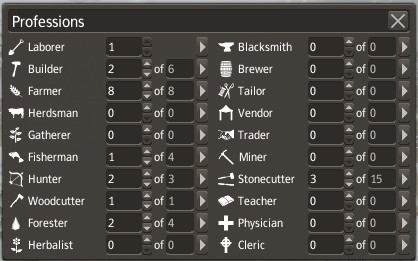
The number next to Laborer is your current amount of laborers - you can assign them to over a dozen professions from the list. The first number next to profession's name is the current number of people in this profession. The second one is the limit of people who can be assigned to it.
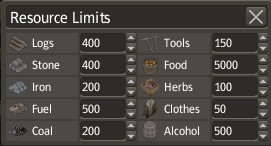
Setting the limit of resource production is important for several reasons. It lets you avoid an overproduction and storing resources you don't need. It also lets you avoid overexploitation of resources that aren't renewable, unless you use specialized buildings and workers. To set limits for resources, go to Tools and reports, then select Show limit places on resource production. You can modify production limits there.
If you don't have enough workers, you can always use Nomads, who may help you with work in exchange for board and lodging in your town. Before you can even think about taking Nomads into your town, you have to build a Town Hall where you can manage the people who come to your town.
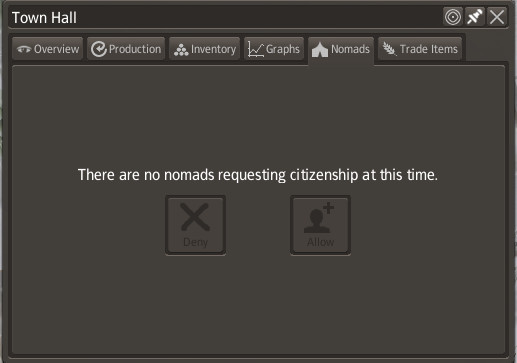
After you build it, go to the Town Hall tab, then select Nomads. You can choose there whether to accept a group of people waiting in front of your town hall or refuse them. Every time you refuse them makes the Nomads less willing to join your town. Every time you accept them, the number of people will increase.
What's important, newcomers can bring various diseases that might cause a plague to spread over your town. Therefore, it's important to have a hospital or - at least - a herbalist that can cure the plague. You should remember that herbs can only help in individual cases and are not effective against a larger number of infected.
Trade not only lets you refill some of your resources, but also buy luxury goods or animals that weren't available earlier. All deals take place in the Trading Post that you have to place next to a river. Remember to place it next to a body of water that's connected to another ones - sometimes there are closed lakes that don't offer a possibility to trade.
You'll get notified about a merchant by a small blue icon in the lower right corner - when you click it, Trading Post will appear. Every merchant that appears in the docks has only products related to a specific category of goods, for example: one of the merchants has only seeds, another one only animals etc. The frequency with which merchants appear in your town depends on the number of trading posts - the more you have, the more merchants will visit you.
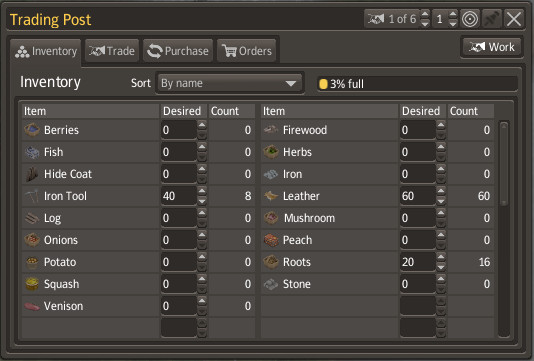
In the first screen you'll see all the resources in a warehouse in the docks - amounts of resources can be modified - remember to acquire the items you want to trade early enough, because when the merchant arrives, it might be too late.
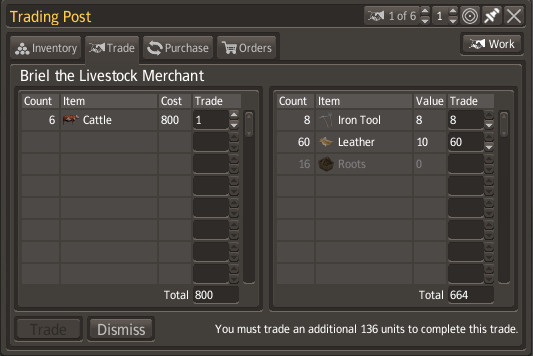
The second screen is strictly related to trade - it's been described in trade process subchapter.
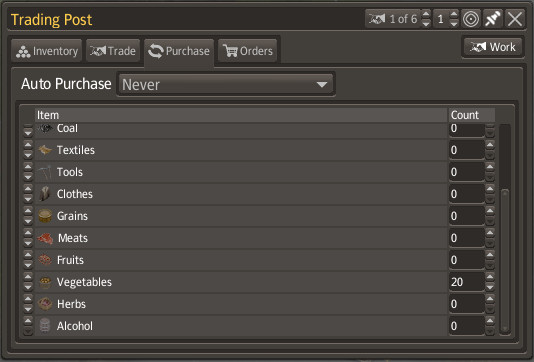
In the third tab you can automatize buying bridge of resources - you can also decide if you want to buy them when a merchant arrives or leaves.
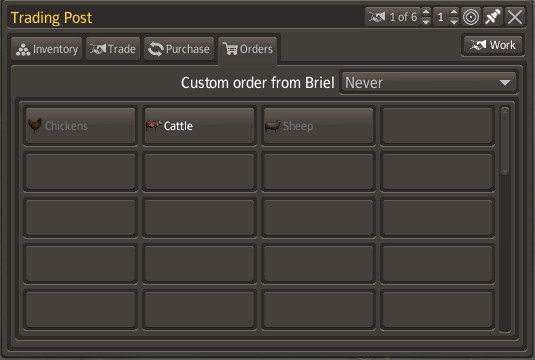
The last tab is used for placing orders - offers of new goods that can be acquired from a selected merchant will appear here.
Trade starts when a merchant arrives in your port - a small blue icon in the lower right corner will notify you about it. When you click it, trading post will appear.
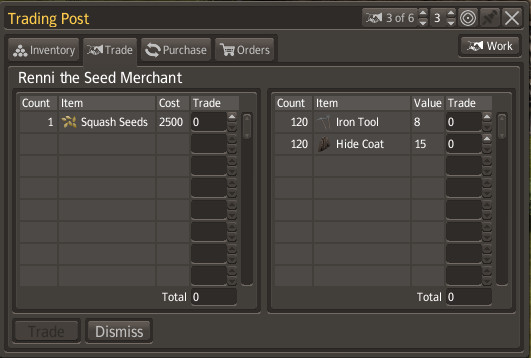
When you click the building, trading screen will appear - the merchant's goods will appear on the left, your resources on the right. Try to match the resources so that their value is the same and you don't overpay for the resources - a notification in the lower right corner will appear if it happens.
You can order resources at any time - you'll find offered resources in the fourth tab. You can order resources by highlighting a proper icon. When you finish buying the goods, send the merchant back by clicking Dismiss.
Goods
Buying value
Selling value
Crops, Orchard, Mushrooms, Fish, Roots, Onions
1
1
Eggs
2
2
Chicken, Venison, Beef, Mutton
3
3
Herbs, Firewood
4
4
Iron, Wool
5
5
Coal
6
6
Stone
7
7
Ale, Iron Tools
8
8
Leather, Steel Tools
10
10
Hide Coat, Wool Coat
15
15
Warm Coat
20
20
Chicken
400
N/A
Sheep
600
N/A
Cattle
800
N/A
Seeds
2500
N/A
Houses are the core of your town - homeless people die faster, they're also more affected by external factors like starvation or cold, so it's necessary to provide them with houses. There are three types of them in the game:
Wooden House - a basic construction that provides a protection from cold. Use it only in the beginning - they aren't very effective and you have to heat them with firewood, so you have to produce more of it.
Cost: 16 units of logs, 8 units of stone
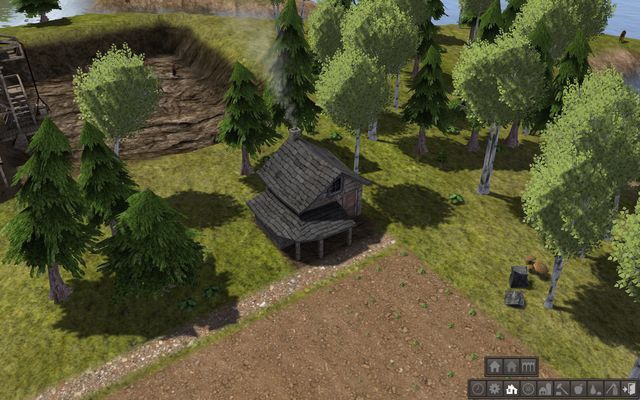 A stone house provides better protection.
A stone house provides better protection.Stone house - a more complex building than its predecessor. It's a basic type of housing that you should build as soon as you stabilize your resource production. Sometimes it's best to buy them from the very beginning - you save logs, because they give more heat than wooden houses.
Cost: 16 units of logs, 8 units of stone, 10 units of iron
Boarding House - if you have problems with homelessness, it's a good idea to build boarding houses, where you'll place people who wait for their own houses. It won't substitute their own homes, but it will improve their happiness and resistance to various external factors.
Cost: 100 units of logs (Logs), 40 units of stone
You can live without roads in Banished, but building them vastly improves mobility of the villagers and transporting resources between buildings. It's a good idea to build roads leading to every possible building in the town - it improves communication and helps you plan further development. There are two types of roads in the game:
Dirt road - the simplest road that doesn't require any resources. It allows faster movement but the difference is not very visible.
Cost: none
Stone road - a much better road, it doesn't wear out and it allows a much faster movement. It's a good thing for developed towns.
Cost: 1 unit of stone for each section
Placing a bridge over a river should be justified economically and it should give you an opportunity to develop your town. Place them only where you can find resources or area where you can build or plant crops on. Build only necessary bridges - too many of them makes roads to the town too long. A wooden bridge is the only option.
Cost: 4 units of logs and 1 unit of stone for each section
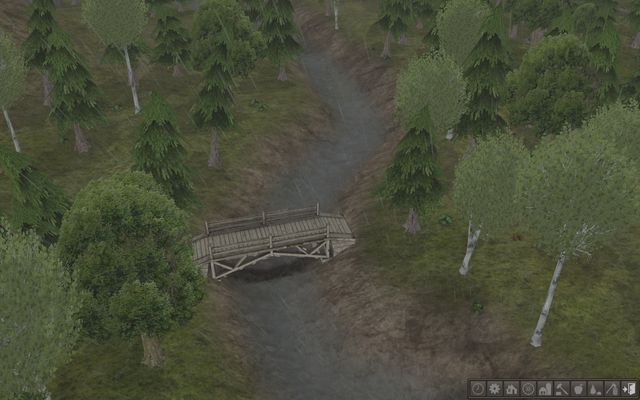 Although it doesn't look sturdy, this bridge is more than enough.
Although it doesn't look sturdy, this bridge is more than enough.Building a tunnel makes it easier to move around mountainous maps. It reduces the time to transport resources between two points.
Cost: 4 units of stone for each section
There's never too much place to store your resources and materials - always make sure that your warehouses aren't overfilled and are placed close to crucial buildings used for production of goods and food. You can store your materials and resources in:
Storage Barn - a building where you can store food and luxury goods: herbs, coats and tools. It's a good idea to place your barns in various places on the map, close to houses and factories - it improves transport of goods.
Cost: 48 units of logs, 16 units of stone
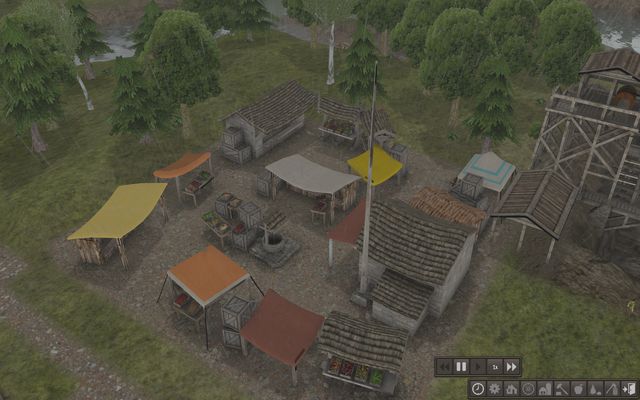 The Market has the biggest range of all storage places.
The Market has the biggest range of all storage places.Stock Pile - place where you can store basic resources like logs, firewood, stone or iron. You can set it up in any free spot - it's best to place them near storage barns so you have all materials in one place.
Cost: none
Market - you can place all available materials there, they will be used by villagers in the range of this building (yellow circle). Market has more capacity than Storage Barn, it's also more versatile, but a few people have to work there, so Markets are recommended further in the game.
Cost: 58 units of logs, 62 units of stone, 40 units of iron
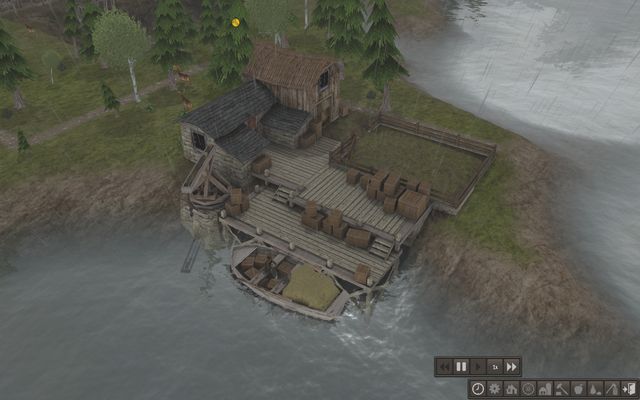 Merchants arrive in your docks every year or two.
Merchants arrive in your docks every year or two.NOTE: Essential information about trade has been described in "Basic gameplay" chapter!
In the game, you can trade with merchants who deliver goods by rivers - they are a source of goods like cattle, chickens or high quality coats. To trade with them, you have to build a Trading Post - you can build it only near a river. Like the Market, it requires workers - it's a good investment if you want to breed cattle or chickens.
Cost: 82 units of logs, 80 units of stone, 40 units of iron
In this section you'll find a variety of public services buildings that improve living conditions in your village and increase happiness and health of villagers. Building them is recommended later in the game:
Well - lets you protect the buildings in case of a fire. Place it near the existing buildings.
Cost: 4 units of logs, 40 units of stone
School House - place where children gain knowledge and become trained workers. You should build it later on because it makes the children become workers later. Without it, the children start working when they're 10, after you build the School House - when they're 20.
Cost: 82 units of logs, 80 units of stone, 40 units of iron
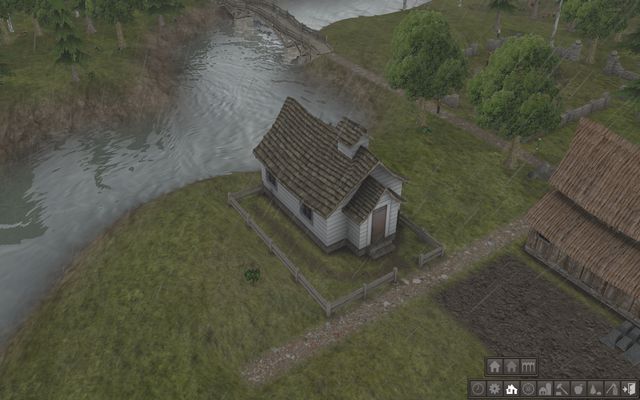 School House is a good way to improve workers' effectiveness after you develop the village.
School House is a good way to improve workers' effectiveness after you develop the village.Hospital - definitely more effective than Herbalist, it also works on a larger scale. Useful when the population of your village is higher than 100 people.
Cost: 52 units of logs, 78 units of stone, 40 units of iron
Town Hall - your residence and the centre of the town, where you can view various gameplay stats: amount of resources, population changes or villagers' happiness. A special panel lets you decide whether to let nomads in (remember to provide them with accommodation and that nomads can't be more than 30% of population), trading panel will let you see all animals and crops bought from the merchants.
Cost: 62 units of logs, 124 units of stone, 48 units of iron
Chapel - building that quickly increases happiness of townsmen - it is a place where older people contemplate their faith, for younger ones it's a place to meet each other, which can lead to creating a family.
Cost: 50 units of logs, 130 units of stone, 30 units of iron
 A cemetery is not only a shrine - it's also an opportunity to meet friends!
A cemetery is not only a shrine - it's also an opportunity to meet friends!Cemetery - place where you can bury the dead townsmen. It increases happiness of the society since the townsmen can visit the graves of their ancestors and members of their families. The number of graves depends on selected size of the cemetery.
Cost: 1 unit of stone for every section
NOTE: Details of producing food have been described in "Food production" chapter!
Buildings used for producing food are core elements of the town - a few weeks from the moment when the food is over. It is therefore essential to make sure that storage barns and markets don't lack food that can be taken home by the villagers. You may produce food with a variety of buildings and crops:
Crop Field - field used for cultivation of various plants - both grains and vegetables. Maximum size of the field is 15x15 units.
Cost: none
 Farming starts in the spring and ends in the late autumn.
Farming starts in the spring and ends in the late autumn.Orchard - the Orchard lets you produce fruit, however it is a very long process, before which you have to plant and grow trees. You can see the effects after a few years, so it's worth buying later on.
Cost: none
Pasture - lets you farm cows, chickens and sheep. Grazing them becomes possible when you buy animals from a merchant (in medium and hard difficulty) or from the beginning (easy).
Cost: 1 unit of logs for each section
Fishing Dock - a building that lets you fish. Part of it must be underwater. In case of smaller rivers, placing the fishing dock properly will let you use it as a bridge.
Cost: 30 units of logs, 16 units of stone
Hunting Cabin - a place for hunters. Hunting gives you not only Venison, but also Leather which you can use to make coats.
Cost: 54 units of logs, 12 units of stone
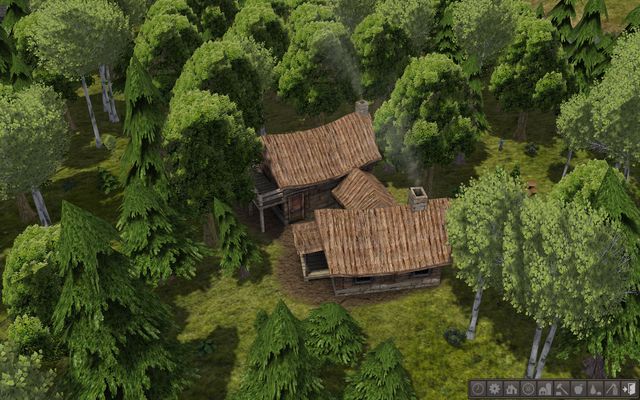 A Hunting Cabin is a good source of venison and leather in the beginning of the game
A Hunting Cabin is a good source of venison and leather in the beginning of the gameGatherer's Hut - a hut where workers gather forest food - mushrooms, berries and roots. They should be built near forests.
Cost: 30 units of logs, 12 units of stone
NOTE: Details of producing and processing resources have been described in "Production and processing of resources"!
Development of the town and survival of townsmen often depends on amount and effective use of resources. It is therefore extremely important to manage them properly and spending them correctly - you can do it with several buildings:
Woodcutter - a building where a woodcutter turns logs into firewood. There's one important restriction, only one worker may work in a hut like this, so you need to build more of them.
Cost: 24 units of logs, 8 units of stone
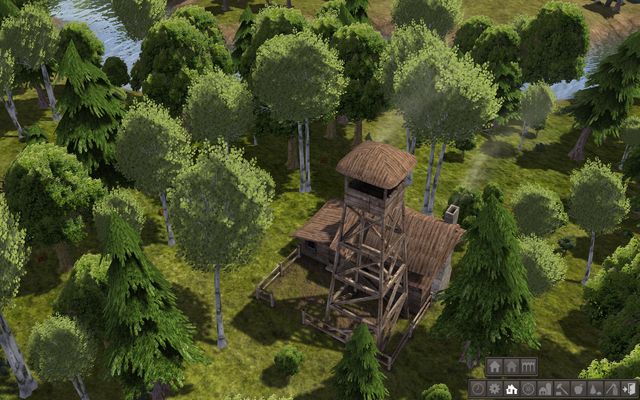 Foresters can plant and cut trees.
Foresters can plant and cut trees.Forester Lodge lets you produce logs from cut trees and planting new ones. The latter option is useful for providing gatherers with food to collect - it appears only close to trees, so more trees mean more resources.
Cost: 32 units of logs, 12 units of stone
Herbalist - a building for herbalists who provide medical care using herbs from areas with many trees. Uneducated workers can add half of a heart to health of one townsman, educated - one heart.
Cost: 30 units of logs, 12 units of stone
Blacksmith - a place where tools are created. They're made of logs and iron, sometimes also coal.
Cost: 55 units of logs, 32 units of stone, 32 units of iron
Tailor - a place where coats are created.
Cost: 32 units of logs, 48 units of stone, 18 units of iron
Tavern - one of the main buildings that affect happiness of townsmen - the Tavern makes beer of six types of fruit and grain. The bigger the variety of alcohol, the better mood of townsmen.
Cost: 52 units of logs, 12 units of stone, 20 units of iron
Mine - a place where iron and coal are mined. It has to be placed near mountains and - unlike the quarry - can be removed.
Cost: 48 units of logs, 68 units of stone
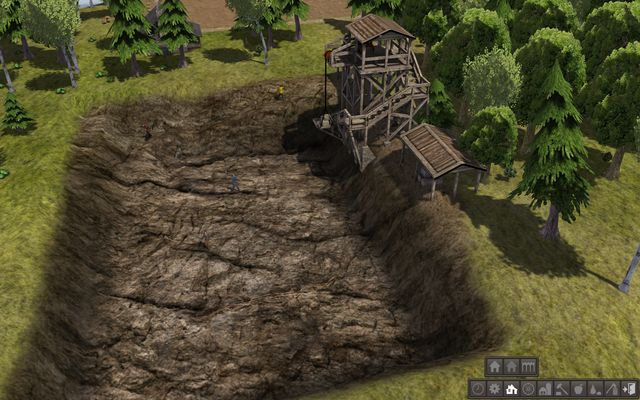 The quarry is not too aesthetic, but it gives you stone.
The quarry is not too aesthetic, but it gives you stone.Quarry - a place where stone is mined. Unlike the Mine, removing the Quarry leaves a hole in the ground. Stone is being depleted there, so after some time the place will be unavailable until the end of the game.
Cost: 80 units of logs, 40 units of stone
What's interesting, you can't build anything in Banished without food. Lack of food will make the workers starve to death, service and production buildings will stop working, happiness will drop, and making up the loss of population will become impossible. Cemetery is the only place that will gain popularity, but you'd rather avoid it. To sum up - food is the bridge important resource in the game. You must not allow your town to lack food at any moment - to produce it, you have to consider some variables: weather, increasing population, insufficient workforce and diversity of food. Try to diversify the types of food - it improves happiness of the townsmen and lets you avoid many diseases that may kill many people. In this chapter you'll find out how to produce food effectively.
Hunting Cabin is a place that you should build in the very beginning of the game - it doesn't require any preparation in terms of breeding animals, and the only requirement is in the availability of wild animals near the place where you plan to place the cabin.
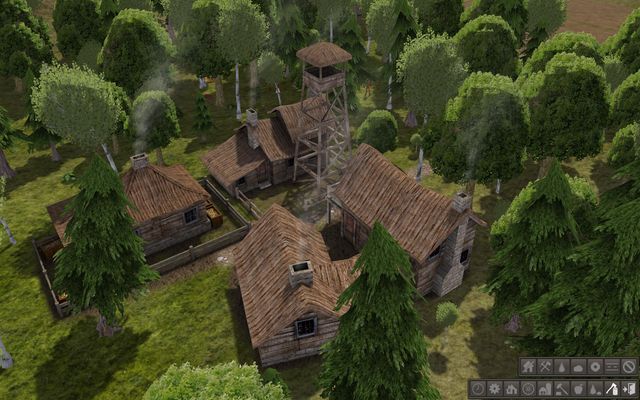 A hunting cabin should be built in a very forested place.
A hunting cabin should be built in a very forested place.It should be built in a forested place - deer tend to stay in the forest, avoiding open spaces. If there are no places like that available, you should make use of your foresters, who can plant trees on an area specified by the range of a forester lodge.
Hunters usually don't kill too many animals so their population doesn't drop. You should, however, build lodges so that their ranges don't overlap - it lets you manage supplies of venison sensibly. It's worth mentioning that hunters produce leather as well, it's used for production of coats so you should think early enough about giving work to hunters sensibly.
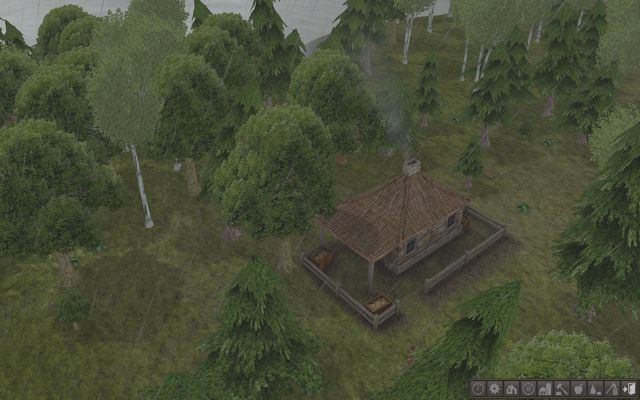 Gatherer's Hut has to be placed in the middle of a forest.
Gatherer's Hut has to be placed in the middle of a forest.Gatherer's Hut is one of the first objects that you should build while thinking about providing food to a newly built village. Being close to a forest is the only requirement. You should make use of foresters who can plant trees on the range of a forester lodge - the more trees there are on the area, the more food will go to your storage barn. Gatherers can gather four types of food:
It lets you diversify the food given to townsmen. Keep in mind that these types of food can only be gathered near fully grown trees, so planting trees won't pay off instantly.
There can be up to four people in a single gatherer's hut.
Fishing Dock will provide your village with fish all the year - rivers don't freeze in the winter, so the fishermen (Fishermen) can exploit the water all the time. It is, however, the least effective way of giving food to townsmen - the amounts of fish transported to storage barns are small and disappear quickly, but they're a good way to diversify the food.
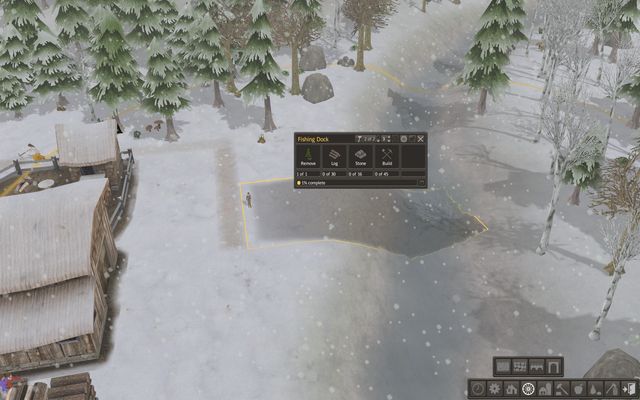 A fishing dock placed like this will let people get to the other side of the river.
A fishing dock placed like this will let people get to the other side of the river.Buying a fishing dock is a good idea only after you build the basic objects used for food production, when you don't have to worry about food supplies anymore. Remember that their ranges shouldn't overlap - it can lead to decreasing the population of fish.
There can be up to four fishermen in a single fishing dock.
Animals grant you access to valuable food. You can breed them on pastures - in Banished you can take care of three types of animals:
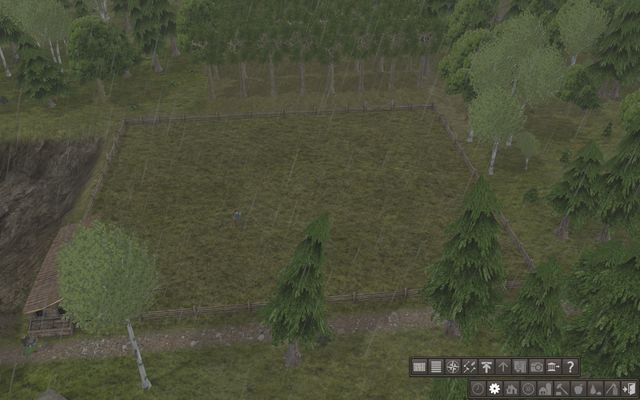 A pasture after a plague is not a pleasant view.
A pasture after a plague is not a pleasant view.The number of animals on a pasture is determined by its size:
- one cow needs 20 units of area;
- one sheep needs 16 units of area;
- one chicken needs only 6 units of area.
Assuming that maximum size of a pasture is 20x20 (400 units of area), on a single pasture you can have at once:
- 20 cows;
- 25 sheep;
- 66 chickens.
Remember that you can have only one type of animals on a single pasture. You can start breeding animals after you buy a trading post - there, with help of merchants, you can buy selected amounts of animals:
Animal
Buying value
Chickens
400
Sheep
600
Cattle
800
Various diseases pose a threat to your animals. In case of a plague, you should move all the animals to another pasture and isolate them until the end of it.
Because you must have a trading post, pastures are recommended for towns that are already developed, after some time they will become a stable source of food, leather and wool.
Orchards are a long-term investment, but they will pay off after a few years. In the first few years you have to plant and grow trees. After four years you'll be able to collect several types of fruit:
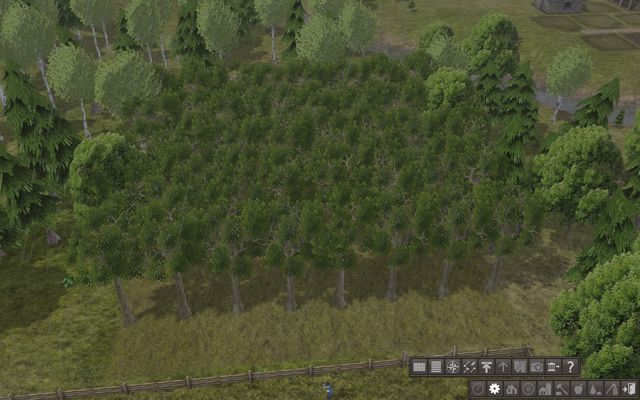 Soon the trees will start producing fruits!
Soon the trees will start producing fruits!Availability of seedlings from the beginning of the game depends on selected difficulty:
You can buy all the seedlings in the trading post when merchants visit you. Each of them costs 2500 units. Maximum size of an orchard is 15x15 units of area.
Saving a place for orchards is a good way to produce more food after spending four years to grow trees, since you don't get any fruit before they're fully grown.
You don't have to spend any money to grow grain and vegetables on crop fields because you select the area to do it by yourself. However, it does not provide food all the year - work in the fields begins in early spring and ends in late autumn. During the game you can grow following crops:
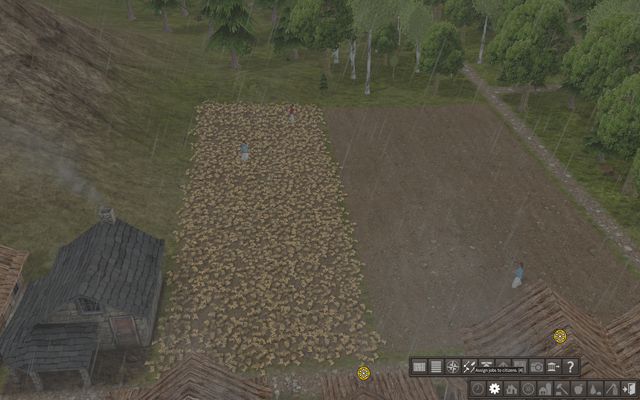 Working hard in the field
Working hard in the fieldAvailability of crops from the beginning of the game depends on selected difficulty:
You can buy seeds of plants mentioned above in the trading post when merchants visit you. Each of them costs 2500 units. Maximum size of a crop field is 15x15 units of area.
The number of workers should match the size of the field. In case of maximum size (15x15), 4-5 citizens should work there. If you see that the farmers can't harvest all crops before winter, you can select early harvest, however in this case they won't plant seeds on all of the field.
Remember to plant various seeds on a field - if you keep planting the same vegetable or grain, soil may become barren, it can also cause a plague that will affect nearby fields as well. Crop rotation should prevent it.
Start growing plants after you build basic sources of food like hunting cabin or gatherer's hut.
Production of logs is crucial for proper functioning of the village you created - your supplies will be used for construction of buildings that are important in various aspects of the town's functioning. Start by cutting trees on a selected area of the map - you'll need some logs from the beginning, so make some workers cut trees.
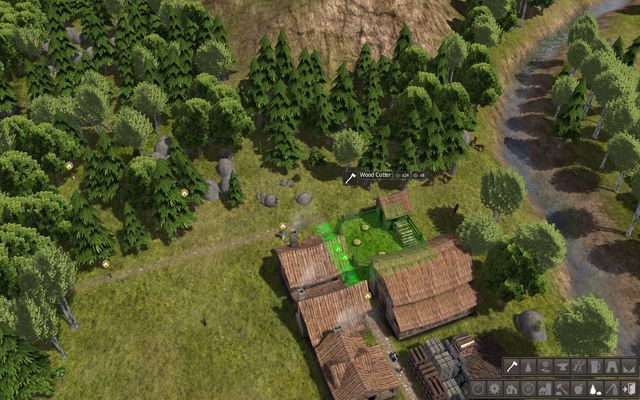 A woodcutter will let you produce firewood.
A woodcutter will let you produce firewood.Later on, it will become a responsibility of workers from the forester lodge - You should build more and more of them as the town expands. While in the beginning they will cut down trees, later on you should order some workers to plant them. The best way to keep a balance in the ecosystem is to make all the lodges cut and plant trees, however remember that to develop your town you need a lot of logs, so sometimes you should choose the amount of resources over balance of the ecosystem.
You can use logs not only for construction. It can also be turned into firewood that's essential for keeping people warm in the late autumn, winter and early spring. To do it, build a woodcutter hut, a worker will make firewood there. You can increase the initial production limit. Remember that the amount of firewood that you need depends on the type of houses. Wooden houses require around 30 units of firewood in the winter, while stone ones - half of that.
In case of stone and iron the initial plan of mining is simple - try to exploit most of natural resources by workers. They will give you enough supplies for at least a few years. Remember that they're not renewable, so you should save some mining spots of both resources for an emergency.
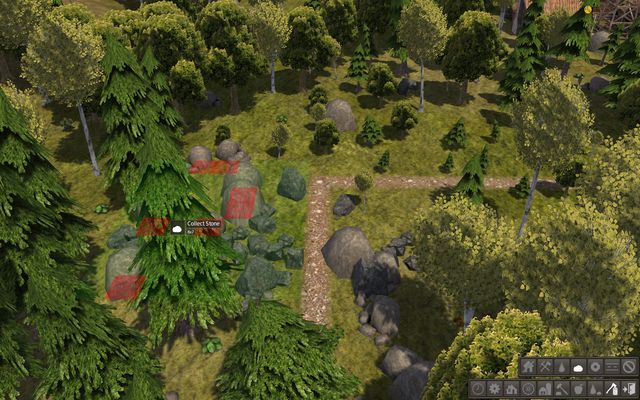 In the beginning, you can collect stone and iron from available lodes.
In the beginning, you can collect stone and iron from available lodes.You can build a quarry in any place, regardless of the availability of resources. Stone can be mined by up to a few dozen workers - remember that the amount of it is not infinite and you can't build anything in a place where a quarry was. Try to place them away from the town.
Mine is used for collecting iron and coal, but you can build it only in the mountains. You can't mine two resources at once, you need to choose only one or keep changing between them. Iron is definitely more versatile, it's used for construction of buildings and making tools. Coal is a more effective source of heat, but it's not much better than firewood. You can also use it to create steel tools, so coal is definitely less versatile.
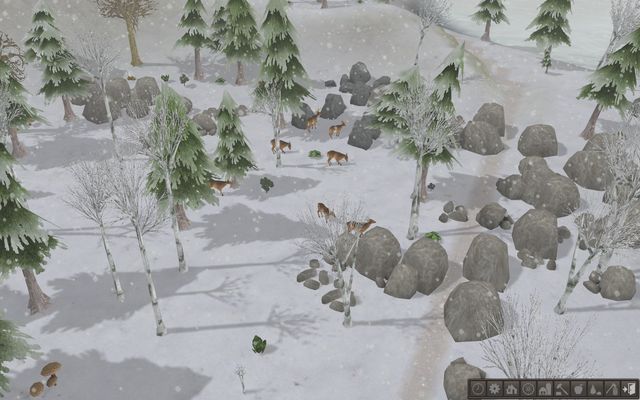 As you can see, there's plenty of animals in the forest.
As you can see, there's plenty of animals in the forest.Leather is made automatically while turning wild animals into food by a hunting cabin and breeding cattle on pastures. You don't have to do anything or give this activity to additional workers. Making wool looks basically the same - to make it, you need to have sheep. You can also buy any of these materials from merchants!
Tools are very important for work in Banished - without them, productivity of workers is visibly lower, rate of getting resources drops. You should build a blacksmith's hut right after you build first houses and food production buildings. A blacksmith makes 2 types of tools:
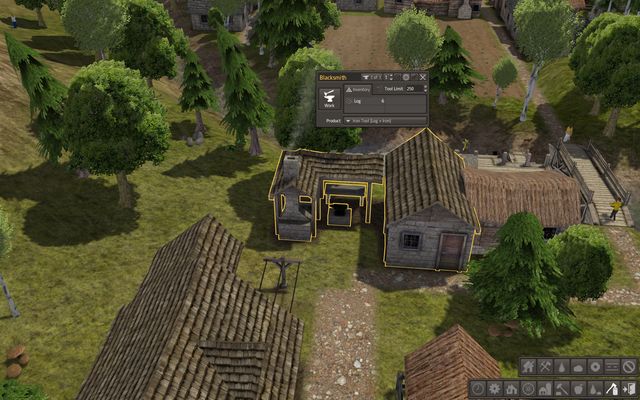 Blacksmith is one of the most important buildings in the game.
Blacksmith is one of the most important buildings in the game.Steel tools last twice as long as iron ones, but they are much more expensive and require coal. That's why in the beginning they are an unnecessary luxury. Start making them after at least a decade. Making steel tools for trade is not a good idea - they are worth only 2 units more than iron tools.
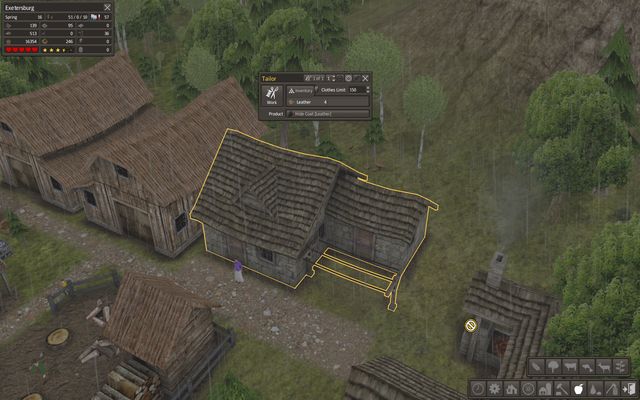 This is the place where coats are created.
This is the place where coats are created.Coats protect the townsmen from cold, especially in the winter. There are three types of coats in the game:
In the beginning of the game, hide coats will be enough - you should make them fairly quickly. After some time it's good to make warmer coats - with them you'll be sure that your workers won't freeze.
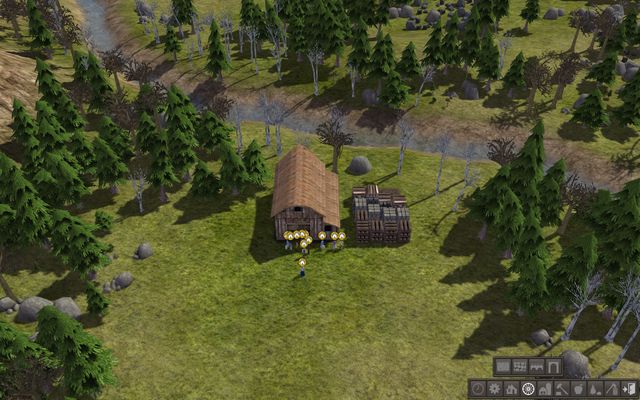
The first object that you should build is the Storage Barn - that's where you'll keep your supplies. Place a stock pile right next to it - you'll keep logs, stone and firewood there .
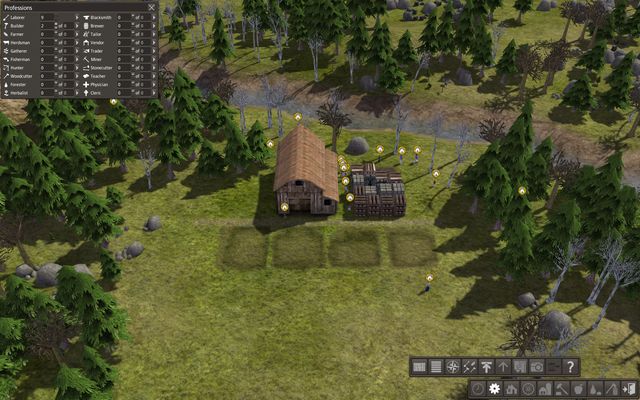
Then you should build some wooden houses as close to the storage barn as possible - remember that you can always upgrade them to stone houses.
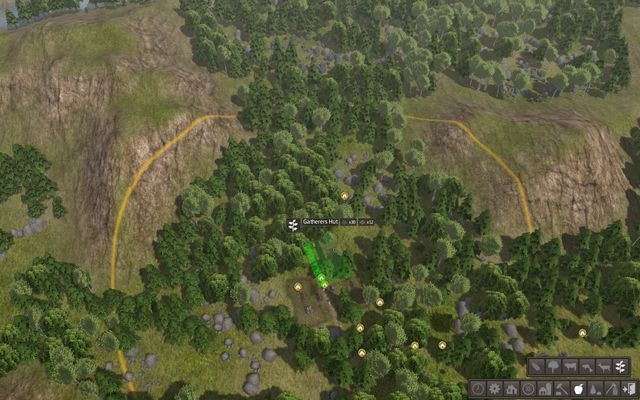
Next, you should build a gatherer's hut near a forest and make as many people as possible work there - forest is a source of large amounts of various food.

Now take care of production of resources - build a forester lodge. Remember to make some workers cut down trees and collect stone from sources on the ground. Try to build a woodcutter's building to make some firewood.
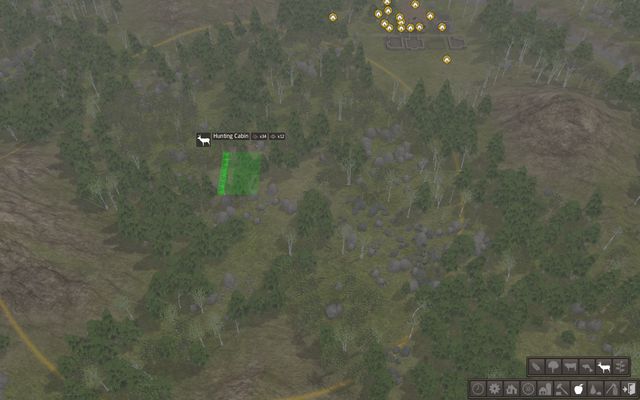
Then you should make more sources of food - to do it, build a hunting cabin. Pay attention to the number of workers in each building. If you don't have resources, keep exploiting the lodes on the ground.
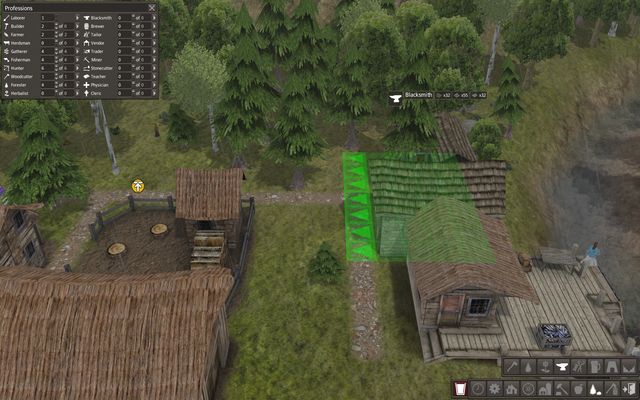
Now it's time to build a blacksmith hut - it will let you create your first tools which will improve the process of collecting resources. In the meantime you can also build a fishing dock and some more houses to increase the population.
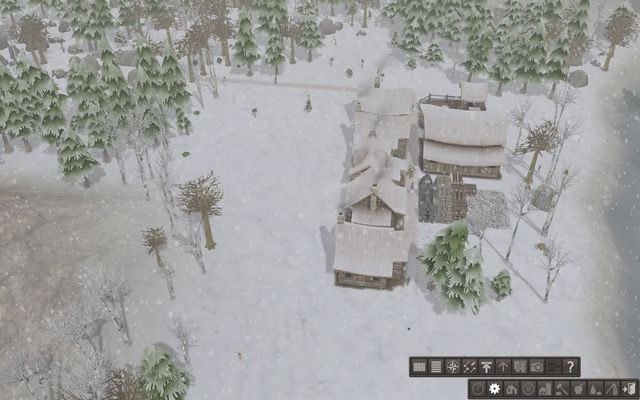
The next thing you should do is building a tailor hut, that will provide the citizens with coats that will protect them from cold. It's also a good moment to set up crop fields and start using them. Then build enough houses and provide access to stone and iron by building a quarry and a mine. Don't forget to build food production object and adjust production limits.
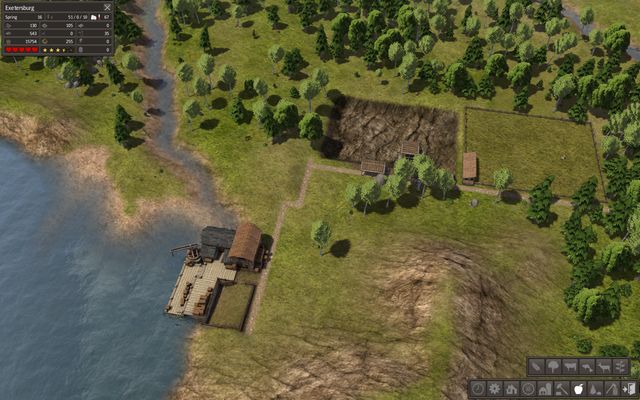 Spring isn't very exciting.
Spring isn't very exciting.Spring is the time when the nature comes back to life. Workers start sowing seeds, orchards become green. Actually, collecting firewood for the winter starts in the spring - try to collect as much as you can to survive the cold without problems.
Spring is the easiest season in the game. Not too much happens, resources are not used too much and food production is just starting. It's a good time to start building new service objects.
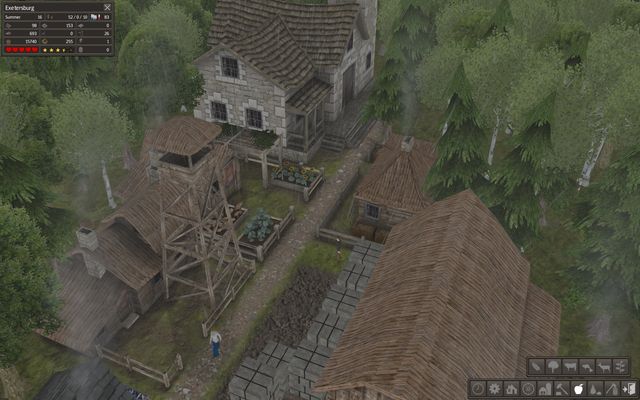 Although it's summer, chimneys still smoke!
Although it's summer, chimneys still smoke!Summer is the time when fruits, grain and vegetables bloom, it's also the best moment to gather herbs and forest fruits. Fires happen in the summer, so remember to place wells near houses and other buildings.
During the hottest months you should look through your supplies and see which ones have to be produced faster.
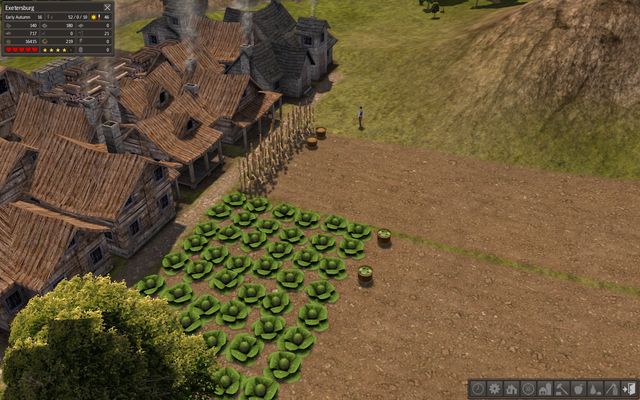 Autumn is the time of harvest, it's the busiest season.
Autumn is the time of harvest, it's the busiest season.Autumn is the busiest season - that's when workers harvest the plants they sowed. Try to harvest all crops before winter - otherwise they will freeze and you won't be able to use them. The same thing applies to fruits.
In the autumn you have to make sure you have enough firewood - without it some townsmen may freeze to death. Check the food supplies as well - after the last harvest, a significant amount of food disappears from barns. It's also a good idea to make sure that you have coats - without them, working in the winter might be impossible. Surviving the winter depends mainly on good preparation.
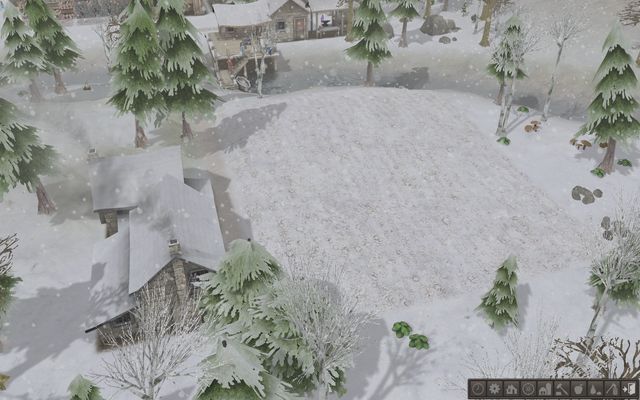 Winter - a time of stagnation...
Winter - a time of stagnation...Crucial part of the year, when you might lose most people because of wrong preparations. In the winter nothing happens in the fields and orchards. It's a good time to tell the farmers to collect resources or cut down trees. Workers without proper coats will not only be ineffective, but may even freeze to death.
Surviving the winter depends only on preparing well - try to plan what supplies you need in advance!
Keeping health and happiness on high levels is a crucial element in terms of your citizens' existence - low morale will lower productivity, while low health increases vulnerability to cold and diseases. Below you'll find pieces of advice that will make keeping high levels of happiness and health easier:
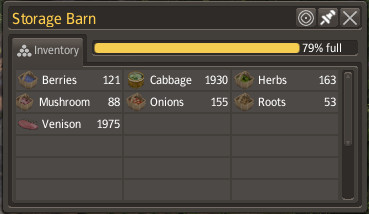 A barn filled like that will make everyone happy.
A barn filled like that will make everyone happy.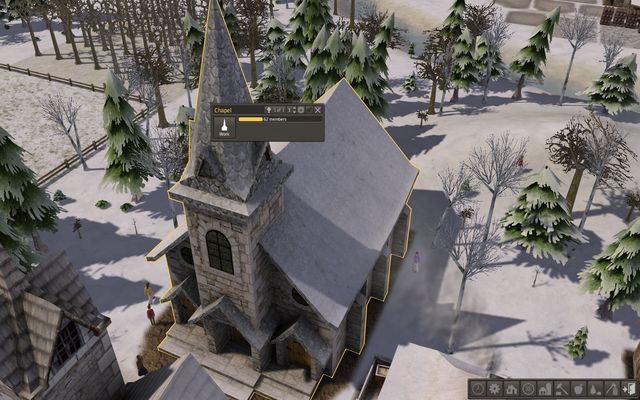 Chapel is a religious center of the town.
Chapel is a religious center of the town.
Name
Description
Settlement
Reach 300 citizens.
Village
Reach 600 citizens.
Town
Reach 900 citizens.
Educated
Have a fully educated society with 200 adults for 4 years.
Uneducated
Have over 300 citizens without building a school.
Jack of all Trades
Build a town with at least 200 people, one of which worked in every profession for at least 5 years.
Mountain Men
Keep a population of 50 for 20 years in harsh climate on a small, mountainous map.
Tombstone
Have at least 400 tombs in your cemeteries.
Blacksmith
Provide steel tools to a population of 200 for 4 years.
Stylish
Provide warm coats to a population of 200 for 4 years.
Isolationist
Have more than 300 citizens without building the trading post.
One with Nature
Have over 400 citizens without creating crop fields, orchards and pastures.
Trader
Trade 50,000 units of goods in a single town.
Master Trader
Trade 100,000 units of goods in a single town.
Exports
Give the trading post 500 units of ale, 300 units of steel tools, 2000 warm coats.
Firefighters
Build 20 wells in a single town.
Farmer
Get 3 types of animals, 8 types of seeds and 8 types of trees.
Livestock
Build a town with 60 cattle, 75 sheep and 180 chickens.
Food Variety
Plant and harvest 8 crops and 8 types of fruit in a single year.
Miner
Have 2 mines with 30 workers each for 3 years.
Mason
Have 2 quarries with 30 workers each for 3 years.
Foodie
Produce 20000 units of food using all available types of food production in a single year.
Lumberjack
Produce 50000 units of logs in 100 years
Stonework
Produce 10000 units of stone in 100 years
Smelter
Produce 10000 units of iron in 100 years
Highwaymen
Build a town with 2000 sections of stone road.
Golden Gate
Build bridge at least 50 sections long.
Immigrants
Let 200 nomads enter your town.
Smiles all Around
Keep a high level of happiness for 10 years in a town with at least 100 citizens.
Healthy
Keep a high level of health for 10 years in a town with at least 100 citizens.
Built from Stone
Build a town with 100 stone houses.
Ready for Anything
Store 2000 units of fuel, 2000 logs, 500 stone, 500 iron, 200 tools, 200 coats and 30000 food at once.
Master Builder
Build a town with 3 churches, 5 boarding houses, 4 markets, 5 hospitals, 2 trading posts, 6 taverns and a city hall.
Builder
Build a town with all available buildings and structures
Established
Build a town with a population of 300 after 100 years.
Tenure
Build a town with a population of 500 after 200 years.
PC version of Banished has rather low system requirements. Shining Rock Studios' game is quite good in terms of graphics and recreates events that took place in a medieval village. The guide was based on PC version, it was plated on Intel Core i5-4570, 4 GB of RAM, MSI Radeon HD7770, the hardware meets the recommended requirements. There was no problem with playing the single player campaign. The game requires online activation on Steam.
Single player: Yes
Offline co-op (split screen/hot seat): No
Online co-op: No
Multiplayer: No
The guide is based on the PC version, the game was played on hardware listed below:
On the hardware above, the game worked without problems, animation was smooth.
Yes, it's possible to play Banished on a laptop.
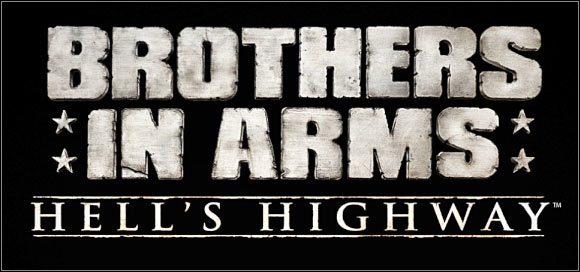

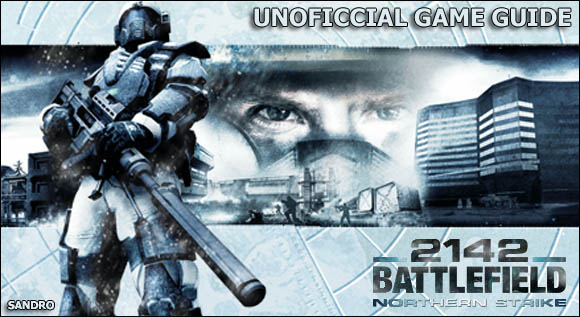
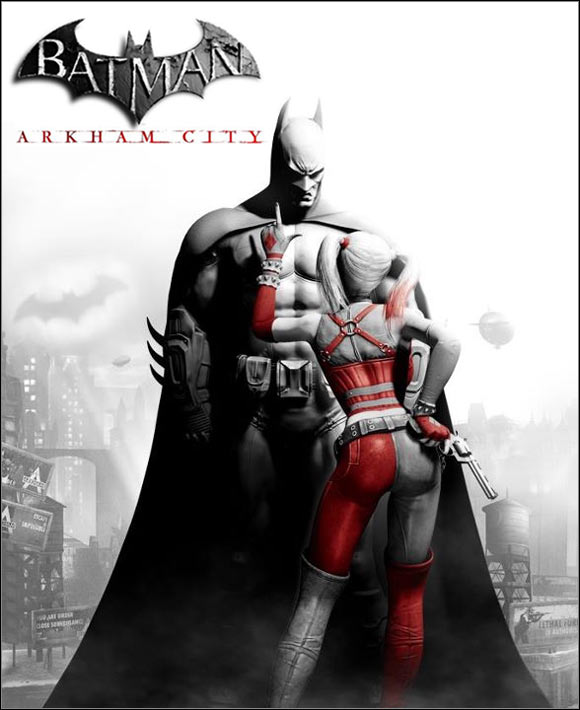
 Battlefield 2142: Northern Strike Game Guide & Walkthrough
Battlefield 2142: Northern Strike Game Guide & Walkthrough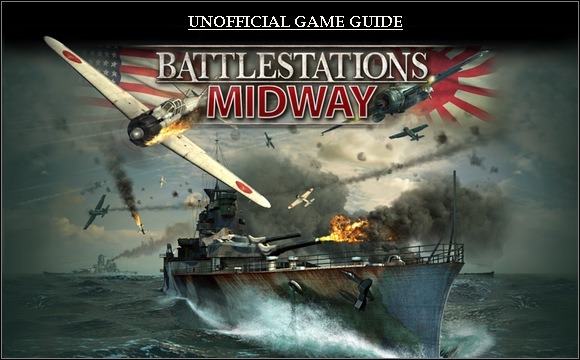 Battlestations: Midway Game Guide & Walkthrough
Battlestations: Midway Game Guide & Walkthrough Batman: Arkham City Game Guide & Walkthrough
Batman: Arkham City Game Guide & Walkthrough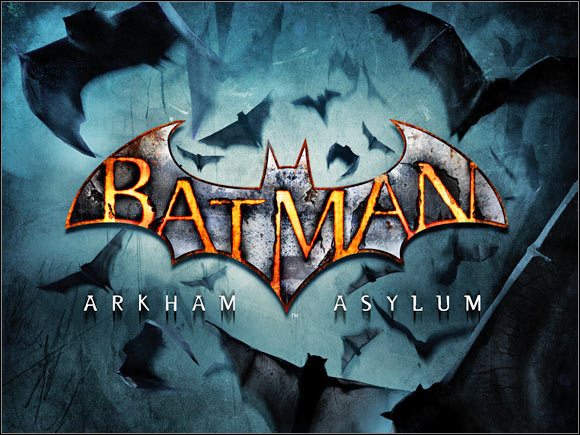 Batman: Arkham Asylum Game Guide & Walkthrough
Batman: Arkham Asylum Game Guide & Walkthrough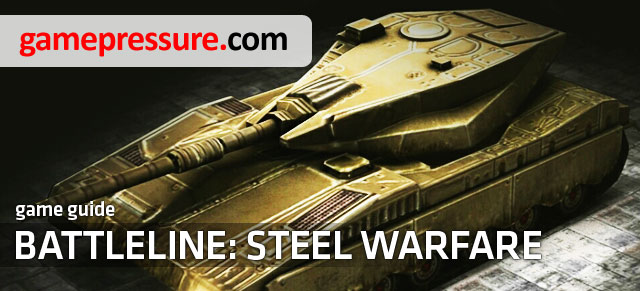 Battleline: Steel Warfare Game Guide & Walkthrough
Battleline: Steel Warfare Game Guide & Walkthrough